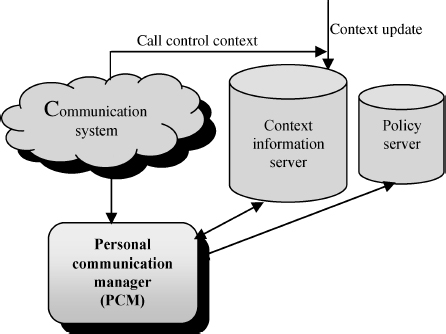15.4 ARCHITECTURE
15.4.1 Elements of the Architecture
In order to provide complex services that are tailored to users' specific desires and preferences, the architectural model needs at least the following functional requirements:

Figure 15.2 The overall architecture.
- collection of context information using sensors as well as dissemination of context information, publishing of presence information from users and their devices,
- description of user policies and preferences, and
- preferences-based ubiquitous handling of communication.
Figure 15.2 presents the overall system architecture.
The communication system is responsible for signaling and communication. The communication part of the architecture is a complex system by itself. Our solution is independent of the underlying communication protocol. It can be based on SIP [10], H.323 [11], or other session protocols. The communication system should provide interoperability between communication protocols of different functionalities.
The requirement that we impose on this architecture is that every message that arrives for a user must be intercepted and dealt with such that user's policies and current context will be considered. We will focus here on the processing of such messages.
The Context Information Server (CIS) controls the context updates and stores and distributes the context information. We are not concerned here about ...
Get Mobile Intelligence now with the O’Reilly learning platform.
O’Reilly members experience books, live events, courses curated by job role, and more from O’Reilly and nearly 200 top publishers.

